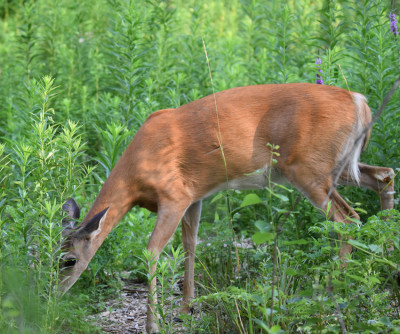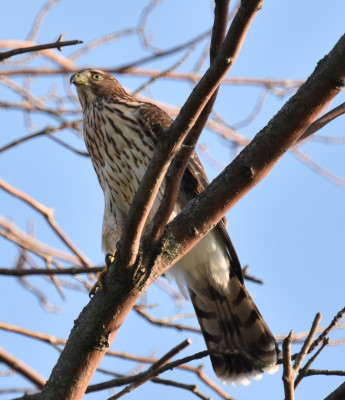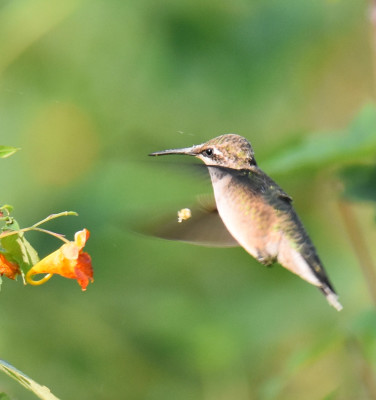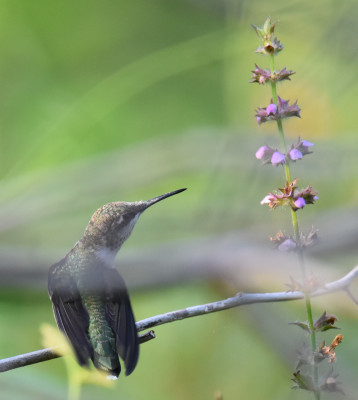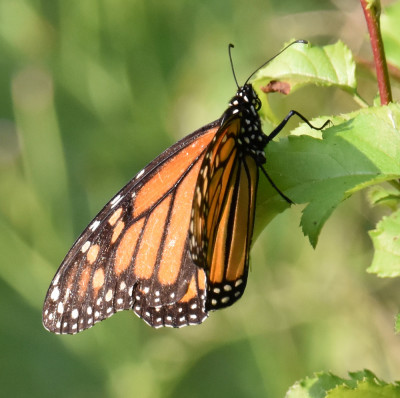This odd summer of 2016 has been hot and humid with no real rainfall for weeks. When I can, I’ve been trying to get out for a short stroll early in the morning before the worst of the weather. Of course everyone has this idea so I’m steadily saying good morning to a stream of striders, joggers, strollers perambulators, canine exercisers and fellow bird and nature watchers. Given the multitudes, I was a bit surprised at just how many captivating and colourful creatures I found on a single hour’s adventure on a recent trip to the Rattray Marsh in Mississauga.
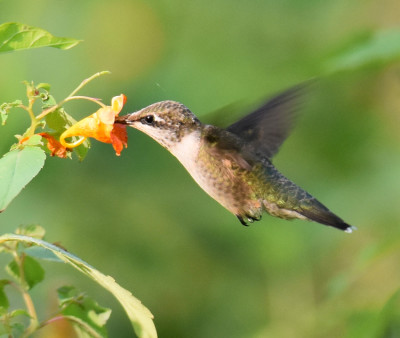
This young male Ruby-throated Hummingbird only has a few dark specks where its bright red feathers will eventually be.
Tiger and Black Swallowtails Stop for Fuel on Cow Parsnip and Teasel
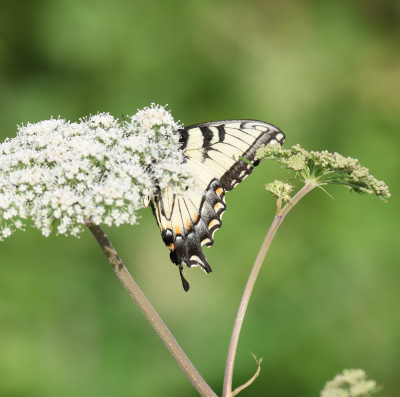
This Tiger Swallowtail may be one of this spring’s caterpillars all grown up.
Despite the lack of rain, many wildflowers are blooming. By slowing down and watching closely, I saw both common types of Swallowtails visiting flowers as they moved around the park in search of mates.
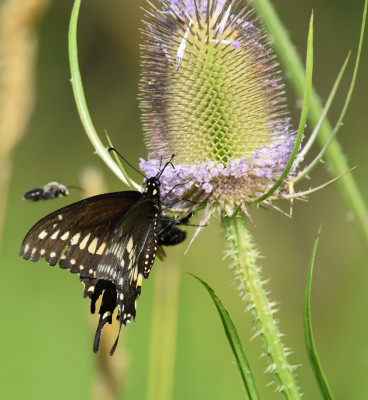
(The bee was an unexpected bonus in this photo.)
Cabbage White butterflies were also up in large numbers. And a single Skipper caught my eye resting in the morning sun.
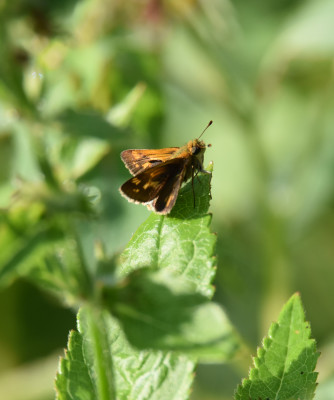
Please don’t ask me which KIND of Skipper this is….There is so much more to learn!
No Dog = Lots of Deer to See
I’ve noticed before that the White-tailed Deer at the Rattray Marsh don’t mind humans much. This young doe actually walked towards me several times while feeding and we ended up about 5 metres apart. No one was walking a dog nearby at the time, though. When I passed the same way a short time later, after meeting 5 dogs and their humans, there was no sign of the doe.
The Cooper’s Hawks Have at Least Two Healthy Young This Year
I watched the Cooper’s Hawks raising chicks this spring and they fledged at least 3 youngsters. This first week of August when I was visiting, I heard two birds steadily crying in a whining almost gull-like way. It was easy to spot the birds as they were moving around the park and pausing in many of the remaining dead trees. Both of the birds I saw, who briefly perched in the same tree, were juvenile Cooper’s Hawks. Hopefully the third bird is still doing well but perhaps is just being quieter because it’s well fed.
Dead Ash Trees Equal an Explosion of Jewelweed to the Joy of Humms
According to a forester I met at the Rattray a few years ago, about 80% of the trees in the park were Ash. Of those about 99.9% are now dead and many of the ones closest to the paths have been removed. That leaves some new clearings adjacent to the trails and the native jewelweeds or touch-me-nots have quickly spread to fill in these gaps. Both Pale (yellow flowers) and Spotted (orange flowers) Jewelweeds are blossoming.
Near one likely patch I slowed down and started looking. Sure enough, there were hummingbirds at work. One flew up and landed on a dead twig about a metre from my face! I could see it was a juvenile male because although it was plain like a female, it was starting to grow the tiny dark feathers that will flash ruby red in the sun when they are fully in.
It then darted down into the Jewelweed patch to feed. I put the camera on Sports Mode and tried to keep it aligned with the bird, hoping for the best. Several shots are tolerably clear which made my great day even better.
The little bird kept changing flowers and perched several times on the dead branches of a felled ash. It may have been getting some sun on its back to recover from a night of near-hibernation, or it may have been keeping a wary eye out for adult hummingbirds that might drive it away from their preferred spot.
At one point, it met a Monarch butterfly that was intending to land on the same plant. The humm chased at it and the Monarch retreated and landed elsewhere.
Hummingbirds do eat insects but I don’t think one would try to catch a butterfly as large as a Monarch even if the colouring didn’t warn it not to try. According to the AllAboutBirds website, typical insect prey is the size of gnats and fruit flies. I did find other nature watchers reporting a Monarch chasing a Hummingbird, and a Hummingbird chasing a Fritillary on a gardening website.
What Else Did I See?
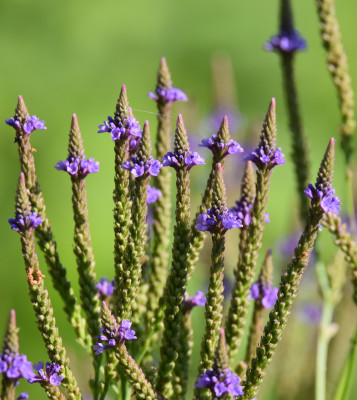
This Blue Vervain looks purple to me!
These are just some of the highlights of my walk. I also saw several types of dragonflies and some curious wasps, some bees and flies and many wildflowers. Along the Lake was a juvenile Spotted Sandpiper and in the Lagoon were two Great Blue Herons, a female or young Hooded Merganser and some gulls. Male Red-winged Blackbirds were still patrolling the cattails and Catbirds were providing snacks to their almost full-sized youngsters. The Chickadees kept popping up near the Cooper’s Hawks and going back about their business when the dangerous birds moved on.
I’m not sure when I’ll get the Rattray next but I’m sure there will be interesting things to observe!
Related Reading
Join In
Have you seen Hummingbirds chasing Monarchs or vice versa? Please share your sighting with a comment.

